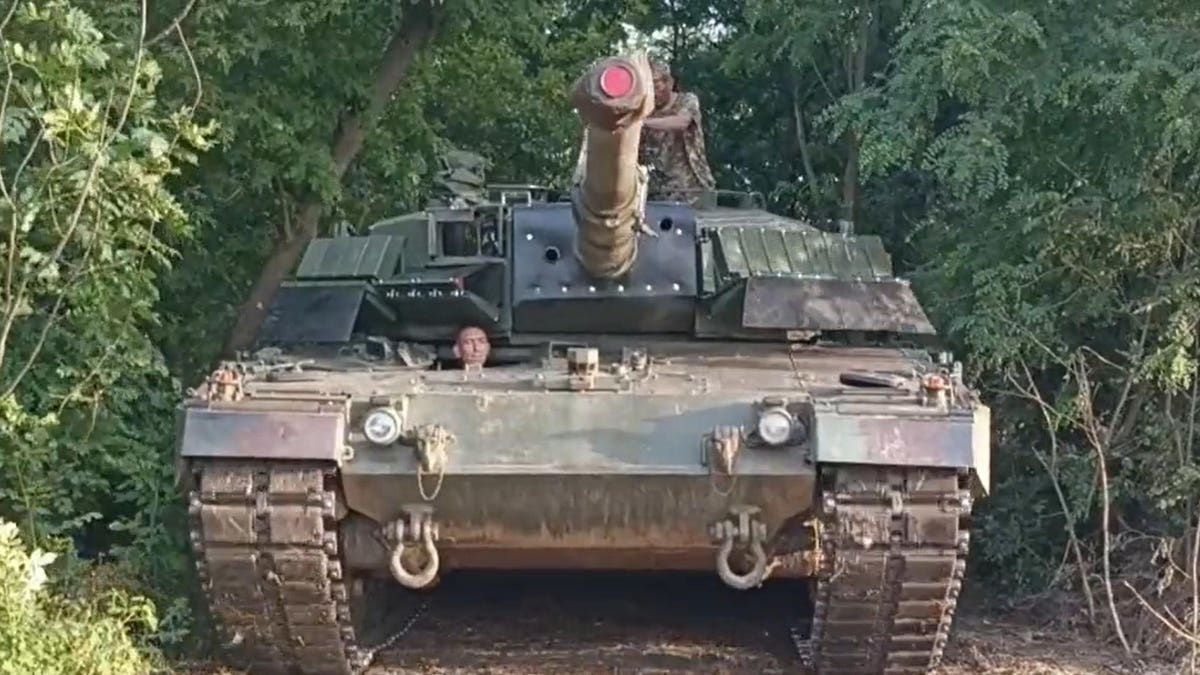The Ukrainian army has begun adding blocks of explosive reactive armor to its German-made Leopard 2A4 tanks, in the process creating a uniquely Ukrainian version of the classic 1980s-vintage tank.
Let’s call it the Leopard 2A4V. In Soviet-Russian-Ukrainian vehicle nomenclature, a “V” indicates the addition of reactive armor.
The first photograph of a Leopard 2A4V circulated online in March. But that photo depicts a 55-ton, four-person Leopard 2 in a workshop somewhere in Ukraine. A video that appeared online around July 1 depicts one of the up-armored tanks in the wild.
It’s unclear how many Leopard 2A4s the Ukrainians have fitted with reactive armor. Kyiv’s foreign allies have pledged to the war effort 85 Leopard 2s, including 54 A4s. So far, around 40 of the 2A4s have arrived in Ukraine.
Probably 30 or so equip a battalion of the 33rd Mechanized Brigade, one of the lead units for Kyiv’s long-anticipated southern counteroffensive, which kicked off on June 4.
We’ve spotted two Leopard 2A4 subvariants with reactive armor. The Leopard 2A4V in the photo from the workshop apparently came from Poland, Norway or Spain, as it lacks the distinctive driver’s sight that sets apart one of the A4s that Canada donated to Ukraine.
The Leopard 2A4V in the more recent outdoor photo clearly is a Canadian model with the unique sight. That could indicate that the Ukrainians aren’t saving their Kontakt reactive armor for any particular Leopard 2A4 subvariant.
The photos on the other hand may not depict tanks belonging to the 33rd Brigade. Several Leopard 2A4s apparently from the 33rd have run afoul of Russian mines or explosives-laden drones, then appeared in photos depicting them in their damaged state. None of the damaged Leopard 2A4s had reactive armor.
That could mean the 33rd Brigade doesn’t operate up-armored Leopard 2A4Vs—and possibly doesn’t plan to. It’s conceivable that the added Kontakt armor is a recent upgrade, and only newly-arrived Leopard 2A4s—perhaps bound for a unit other than the 33rd—are getting the modification.
It’s clear why the Ukrainian army would want to add reactive armor to as many as its Leopard 2A4s as it can.
The armor—literally slices of plastic explosives sandwiched inside a metal container—explodes outward when struck by enemy fire. The outgoing blast can help to deflect the incoming blast, destroying the armor but hopefully sparing the vehicle it’s attached it.
The Soviet Union developed explosive reactive armor in the 1960s as an expedient: a way cheaply and effectively to enhance the protection of existing tanks.
Thus a T-62M tank with 150 millimeters of steel armor became a T-62MV with 150 millimeters of steel protection plus the equivalent of another hundred or so millimeters of steel thanks to the addition of ERA. T-64Bs became T-64BVs. T-80Bs became T-80BVs, et cetera.
The Leopard 2A4 is an aging tank. Its steel and tungsten armor in some places offers the same protection as 800 millimeters of steel. That’s less protection than, say, a newer American M-1A1 or German Leopard 2A6 enjoys.
Adding explosive reactive armor could boost a Leopard 2A4’s protection to the equivalent of around a thousand millimeters of steel wherever the ERA blocks are attached. It’s not for no reason that Turkey rushed to add reactive armor to its own Leopard 2A4s after losing several of the tanks in fighting in Syria in 2016.
But note: explosive reactive armor works best against high-explosive rounds. It’s less effective against non-explosive tungsten penetrators. And ERA can impede sensitive equipment such as sights—and even damage this equipment when the armor explodes.
As it happens, sights tend to be concentrated on the top of a tank’s turret. It also happens that the Leopard 2A4’s thinnest armor is on its turret top. In other words, the place where a Leopard 2A4 most would benefit from add-on armor is the same place where explosive armor might inflict nearly as much damage as it prevents.
So reactive armor isn’t a panacea. It can enhance a Leopard 2A4’s protection, but only to a point. And it won’t do anything to safeguard a Leopard 2A4V from what arguably is the greatest threat it and every other tank type faces on the Ukraine battlefield: buried anti-tank mines, which tend to damage a tank’s tracks and immobilize it even when they don’t destroy it.
But a Leopard 2A4V indisputably is better-protected than a standard Leopard 2A4 is. And that extra armor, however uneven and imperfect, still could save a few precious tanks and—more importantly—their crews.
Read the full article here





